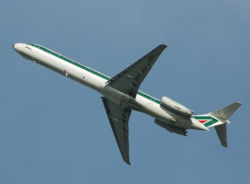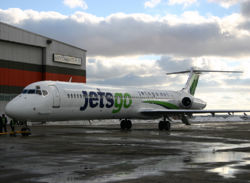PlaneSpottingWorld welcomes all new members! Please gives your ideas at the Terminal.
McDonnell Douglas MD-80/MD-90
| MD-80 and MD-90 | |
|---|---|
| The MD-82, pictured, had improved range over the MD-81. | |
| Type | Airliner |
| Manufacturers | McDonnell Douglas Boeing |
| Designed by | McDonnell Douglas |
| Maiden flight | MD-80 series: 1979-10-25 MD-90: 1993-02-22 |
| Introduced | MD-80 series: 1980 with Swissair and Austrian Airlines MD-90: 1995 with Delta Air Lines |
| Status | Out of Production |
| Primary users | American Airlines (MD-80: 353) Delta (MD-80: 120, MD-90: 16) Alitalia (MD-80: 75) SAS (MD-80: 47, MD-90: 1) |
| Produced | MD-80 series: 1979-1999 MD-90: 1993-2001 |
| Number built | MD-80 series: 1,191 MD-90: 117 |
| Unit cost | US$41.5-48.5 million |
| Developed from | McDonnell Douglas DC-9 |
| Variants | Boeing 717 |
The McDonnell Douglas MD-80 and MD-90 are twin-engine, single-aisle jet commercial aircraft derived from the DC-9. The MD-80 was introduced in 1980 and was followed in modified forms by the MD-90 in 1989 and Boeing 717 in 1998. The 717 was originally named the MD-95, but was renamed after the McDonnell Douglas—Boeing merger. As of May 23, 2006, with the final two deliveries of the Boeing 717, production of the DC-9 aircraft family ceased after 41 years.
Contents
Background
Douglas Aircraft developed the DC-9 in the 1960s as a short-range companion to their larger DC-8. The DC-9 was an all-new design, using two rear fuselage-mounted turbofan engines, and a T-tail. The DC-9 aircraft have distinctive 5-abreast seating and holds 80 to 135 passengers depending on seating arrangement and aircraft version.
The MD-80 series was the second generation of the DC-9. It was originally called the DC-9-80 series and entered service in 1980. The MD-80 series was then developed into the MD-90 entering service in 1995. The last variant of the family was the MD-95, which was renamed the Boeing 717-200 after McDonnell Douglas's merger with Boeing in 1997.
The DC-9 family is one of the most successful jet airliners with total sales of over 2,400 units; it ranks third behind the second place Airbus A320 family with 3,000 total sales, and the first place Boeing 737 with over 6,000 total sales.
MD-80 series

The MD-80 series is a mid-size, medium-range airliner that was introduced in 1980. The design was second generation of the DC-9 with two rear fuselage-mounted turbofan engines, small, highly efficient wings, and a T-tail. The aircraft has a distinctive 5-abreast seating in coach class. It was a lengthened DC-9-50 with a higher maximum take-off weight (MTOW) and the ability to carry more fuel. The airplane series was designed for frequent, short-haul flights for 130 to 172 passengers depending on plane version and seating arrangement. Originally it was designated DC-9-80 and marketed as the "DC-9 Super 80". That was changed to MD-80 before the initial launch as a marketing move to show that McDonnell Douglas had a new airliner for the 1980s.
The MD-80 series entered service in 1980. It was typically known as the "MD-80" or "Super 80". The versions of the series were the MD-81/82/83/88 and the shortened MD-87. The MD-80 versions have cockpit, avionics and aerodynamic upgrades along with the more powerful, efficient and quieter JT8D-200 series engines, which are a significant upgrade over the smaller JT8D-15, -17, -11, and -9 series. The MD-80 series aircraft also have longer fuselages than their earlier DC-9 counterparts, as well as longer range. The MD-80's production ended in 1999. Notably, launch customers American Airlines and Alitalia still, as of 2006, refer to the planes in fleet documentation as "Super 80" or "SP80". This model is still flown extensively by American Airlines and Delta Air Lines on domestic routes.
The MD-80's closest competitor was the Boeing 737-400.
The MD-80 series has been used by airlines around the world. Major customers include Aeroméxico, Allegiant Air, Northwest Airlines, American Airlines, Austrian Airlines, Delta Air Lines, Swissair, Alitalia, Scandinavian Airlines System (SAS), Finnair, Iberia, Japan Air System (JAS), China Eastern Airlines, Midwest Airlines, China Northern Airlines, Alaska Airlines, Korean Air, and Austral Líneas Aéreas. Many of the airlines have, however, started to retire the type in the 2000s.
In August 2006 a total of 1,064 MD-80 aircraft (all variants) were in airline service, including China Southern Airlines (23), Japan Airlines (21), Alitalia (75), Iberia Airlines (32), Scandinavian Airlines System (47), Spanair (36), Aeroméxico (32), Alaska Airlines (26), Allegiant Air (24), American Airlines (353) and Delta Air Lines (120). Some 59 other airlines operate smaller numbers of the type.[1]
MD-90
The MD-90 is a mid-size, medium-range airliner that was developed from the MD-80 series. It was a 5 feet longer, updated version of the MD-88 with a similar electronic flight instrument system (EFIS), (glass cockpit) and even more powerful, quieter and fuel efficient IAE V2500 engines. The MD-90 features seating for 153 to 172 passengers depending on seating arrangement.
The MD-90 was launched in 1989, first flew in 1993 and entered service in 1995. The MD-90 came in two versons: -30 and -30ER. The -30 had a range of 2,400 miles. The -30ER had a higher gross weight and range up to 2,750 miles with an auxiliary fuel tank.
MD-90 production ended in 2001 due to internal competition with Boeing's own 737-800 after Boeing and McDonnell Douglas merged in 1997. The final 20 MD-90s were built under contract in China under the Trunkliner program.[1][2] The MD-90 is the least successful member of the DC-9 family with 117 planes sold.
The main competitors of the MD-90 included the Airbus A320 and the Boeing 737-800.
MD-90 major customers include Delta Air Lines, Saudi Arabian Airlines, Japan Air System (JAS) and Scandinavian Airlines System (SAS). Of special note is that Delta Air Lines had initially placed a large order for the MD-90 to replace some aging Boeing 727s. After the Boeing-McDonnell Douglas merger, Delta cancelled their remaining MD-90 orders in favor of the Boeing 737-800.
In August 2006 a total of 110 Boeing MD-90 aircraft were in airline service with China Eastern Airlines (9), China Southern Airlines (13), Japan Airlines (16), Lion Air (5), Saudi Arabian Airlines (29), Uni Air (11), Blue1 (3), Hello (6), Nordic Regional (2), Scandinavian Airlines System (1) and Delta Air Lines (16).[1]
MD-95
The shortened MD-95 was developed to satisfy the market need of a replacement for early DC-9 models, then approaching 30 years old. The project was a complete overhaul of the system, going back to the original DC-9 and reinventing it for modern transport. The aircraft is 1.45 m longer than the DC-9-30 and is powered by new Rolls-Royce BR715 engines. It has a six screen flat panel liquid crystal display showing the primary flight display, navigation display, and multi-mode engine & systems display.
A total of 156 717-200 airplanes were produced from 1998 to 2006. The 717-200 saw major domestic orders from Trans World Airlines, Valujet Airlines (now AirTran Airways), and Midwest Airlines. Major operators include AirTran (87), Midwest Airlines (25) and Hawaiian Airlines (11) as of August 2006.[1]
Specifications
| MD-81 | MD-82/-88 | MD-83 | MD-87 | MD-90-30ER | |
|---|---|---|---|---|---|
| Passengers | 155 (2 class) 172 (1 class) |
152 (2 class) 172 (1 class) |
155 (2 class) 172 (1 class) |
130 (2 class) 139 (1 class) |
153 (2 class) 172 (1 class) |
| MTOW | 140,000 lb (64,000 kg) | 149,500 lb (67,800 kg) | 160,000 lb (72,600 kg) | 140,000 lb (64,000 kg) | 166,000 lb (70,760 kg) |
| Range | 1,570 nm (2,900 km) | 2,050 nm (3,800 km) | 2,500 nm (4,600 km) | 2,400 nm (4,400 km) | 2,750 nm (4,425 km) |
| Cruise speed | 438 knots (504 mph, 811 km/h) | ||||
| Length | 147 ft 8 in (45.1 m) | 130 ft 4 in (39.7 m) | 152 ft 7 in (46.5 m) | ||
| Wingspan | 107 ft 8 in (32.8 m) | 107 ft 10 in (32.87 m) | |||
| Height | 29 ft 6 in (9.05 m) | 30 ft 5 in (9.3 m) | 30 ft 6 in (9.4 m) | ||
| Powerplant (2 x) | P&W JT8D-209 18,500 lbf (82.29 kN) |
P&W JT8D-217A/C or -219 20,000 lbf (88.96 kN) |
P&W JT8D-219 21,000 lbf (93.41 kN) |
P&W JT8D-217C 20,000 lbf (88.96 kN) |
IAE V2525-D5 25,000 lbf (111.21 kN) |
Trivia
- Dallas-Fort Worth International Airport is home to the highest number of McDonnell Douglas MD-80 operations in the world, and is the main hub of American Airlines, the largest MD-80 operator. Hartsfield-Jackson Atlanta International Airport, the main hub for the second largest MD-80 operator, Delta Air Lines, comes in second.[citation needed]
References
- ↑ 1.0 1.1 1.2 Flight International, 3-9 October 2006
External links
Related content
Comparable aircraft
Related lists
See also
Lists relating to aviation | |
|---|---|
| General | Timeline of aviation · Aircraft · Aircraft manufacturers · Aircraft engines · Aircraft engine manufacturers · Airports · Airlines |
| Military | Air forces · Aircraft weapons · Missiles · Unmanned aerial vehicles (UAVs) · Experimental aircraft |
| Notable incidents and accidents | Military aviation · Airliners · General aviation · Famous aviation-related deaths |
| Records | Flight airspeed record · Flight distance record · Flight altitude record · Flight endurance record · Most produced aircraft |
de:McDonnell Douglas MD-80 et:McDonnell Douglas MD-80/MD-90 fr:McDonnell Douglas MD-80 hr:McDonnell Douglas MD-80/MD-90 it:McDonnell Douglas MD-80 ja:MD-80/MD-90 nn:McDonnell Douglas MD-80 fi:McDonnell Douglas MD-80 sv:McDonnell Douglas MD-80 zh:MD-80


